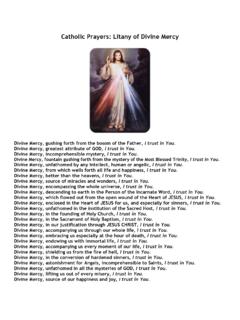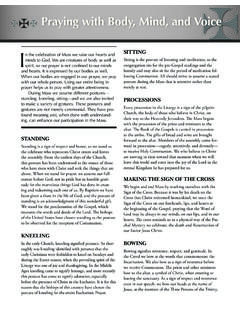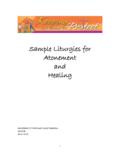Transcription of Guidelines - Music Within the Mass - Liturgy Handbook
1 Guidelines : Music Within the mass By Paul Mason, Coordinator of Liturgy , Diocese of Wollongong Introduction This newly published guideline for Music Within the mass is intended to provide continuity with previous guidance, updated to include changes in resources in the past five years. The purpose of these Guidelines is to provide support to parish and school Music leaders and groups in their day-to-day ministry of Music Within the mass . The document recalls the centrality of the Eucharist to our Catholic way of life, helps in understanding the purpose and importance of Music Within the mass , identifies the assembly as the primary Music minister, details the important role of specialist Music ministers in preparation and coordination of the assembly's Music ministry, identifies the different forms of liturgical song Within the mass , helps guide the selection of the parts of mass to be sung.
2 Explains the options and helps guide the selection of Music for the various parts of the mass , identifies other key concerns for parish and school Music ministry as well as strategies and resources to address them. These Guidelines should be read Within the context of the Model of Music Ministry . outlined in the PSALMIST program, announced in May 2012 and published in the June 2012 edition of the Diocese's Faith and Life e-newsletter. These Guidelines are used in the preparation of the Music Recommendations for Sundays , published in the Diocese's Faith and Life e-newsletter each month.
3 It is hoped that these Guidelines will assist you in your Music ministry and help make our celebration of the mass an uplifting experience of the community at prayer and worship . (Goal B, Diocesan Pastoral Plan 2011-2015). Acknowledgments and References Some of the material has been previously published in the following media: (1) various pages on the Liturgical Song website initially published in 2007 ( ); and (2) Diocese of Broken Bay Liturgy Commission, Music Within the mass , 2008, now out-of-print. For further discussion on the pastoral implications of John Paul II's Chirograph on Sacred Music see: Paul Mason, The Pastoral Implications of John Paul II's Chirograph for the Centenary of the Motu Proprio Tra Le Sollecitudini' on Sacred Music .
4 Worship 82:5 (September 2008), 386-413. Faith and Life Liturgy Notes, vol 1 no 10 (December, 2012). 2. The Centrality of Liturgy and the Eucharist As Catholics, we know that celebrating the Liturgy of the Church is at the heart of the way we give glory to God. The term Liturgy ' has its origins in the Greek word , meaning public work' or a 'service in the name of / on behalf of the people.' This word appears throughout the New Testament, and is understood to mean the participation of the People of God in the work of the Triune God (cf.)
5 Lk 1:23; Acts 13:2; Rom 15:16, 27;. 2 Cor 9:12; Phil 2:14-17, 25, 30; Heb 8:2, 6). Through Liturgy , Christ continues the work of our redemption in, with and through his Church. The Liturgy is our way of participating publicly in the ongoing work of Christ in worship, proclamation of the Gospel and active charity to the glory of God (Catechism of the Catholic Church (CCC), 1069-70). No wonder the Second Vatican Council described Liturgy as the summit and source of the Church's activity (Constitution on Sacred Liturgy , Sacrosanctum Concilium, 10), and Eucharist (the mass ) as the source and summit of Christian life (Dogmatic Constitution on the Church, Lumen Gentium, 11).
6 The Function and Importance of Music in Liturgy Our model for Music in the Liturgy is Jesus himself, who sang psalms with the apostles at the Last Supper (Mt 26:30; Mk 14:26). Music is an integral part of our participation in Liturgy an integral part of our participation in the work of God. For when song and Music are signs of the Holy Spirit's presence and action, they encourage, in a certain way, communion with the Trinity (John Paul II, Address to the Pontifical Institute of Sacred Music , 3; Chirograph on Sacred Music , 3).
7 The Second Vatican Council's Constitution on Sacred Liturgy (CSL) made particular mention of the role of Music in fulfilling the purpose of Liturgy , which is the glory of God and the sanctification of the faithful (CSL 112). The Second Vatican Council's Instruction on Music in the Liturgy , Musicam Sacram (MS), mentions five specific ministerial functions of Music in the Liturgy . Through Music in the Liturgy : 1. prayer is given a more graceful expression, 2. the mystery of the Liturgy , with its hierarchical and community nature, is more openly shown, 3.
8 The unity of hearts is more profoundly achieved by the union of voices, 4. minds are more easily raised to heavenly things by the beauty of the Liturgy , and 5. the whole celebration more clearly prefigures the heavenly Liturgy (cf. MS 4-5). One cannot find anything more religious and more joyful in sacred celebrations than a whole congregation expressing its faith and devotion in song (MS 16). Great importance should therefore be attached to the use of singing in the celebration of the mass , with due consideration for the culture of peoples and abilities of each liturgical assembly.
9 Although it is not always necessary ( , in weekday Masses) to sing all the texts that are in principle meant to be sung, every care should be taken that singing by the ministers and the people is not absent in celebrations that occur on Sundays and on holy days of obligation (General Instruction of the Roman Missal (GIRM), 40). Our preparation and leadership of Music Within the mass greatly assists the People of God, the community as the body of Christ, to experience "new life in the Spirit, involvement in the mission of the Church, and service to her unity" (CCC 1072).
10 Faith and Life Liturgy Notes, vol 1 no 10 (December, 2012). 3. The Role of the Music Ministry The primary Music minister in the Liturgy is the assembly. At certain times the priest, the deacon, the choir, the musicians, the psalmist and the cantor have specific roles of their own. But there is no place in the Liturgy for performances of art for art's sake. Of special importance are the roles of Music director, choir director and Music coordinator, who are responsible for preparing, rehearsing and conducting the musical aspects of liturgical celebrations.





